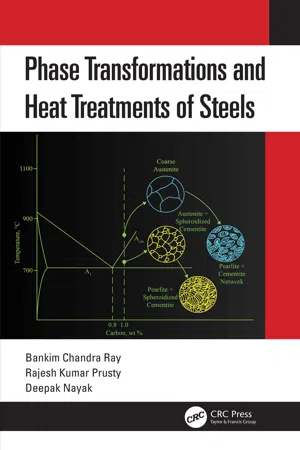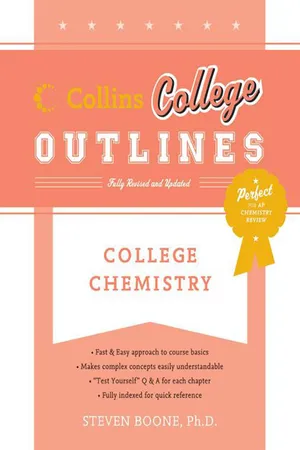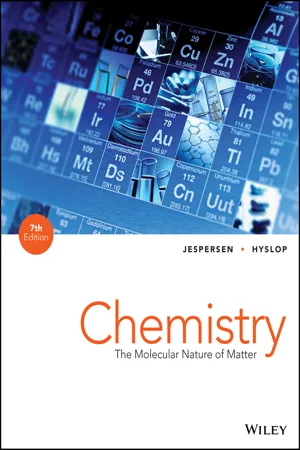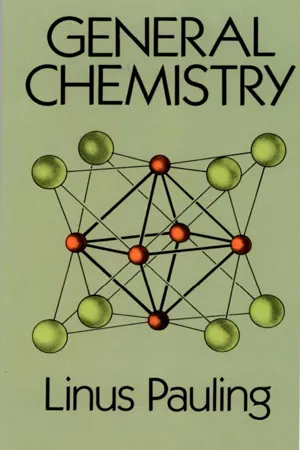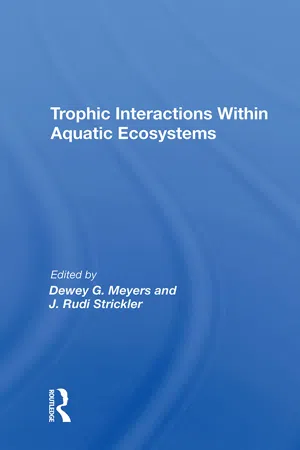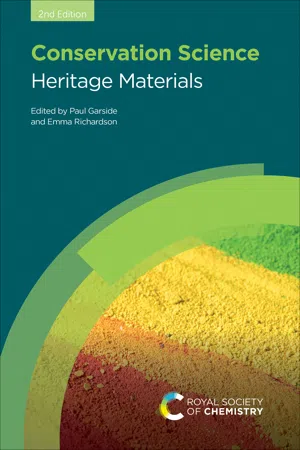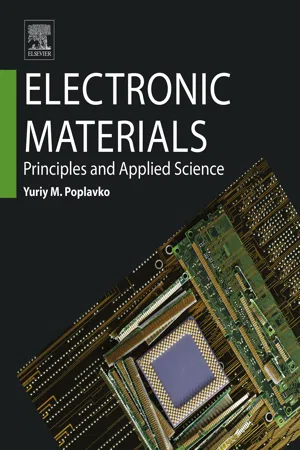Chemistry
Metals Non-Metals and Metalloids
Metals, non-metals, and metalloids are the three main categories of elements on the periodic table. Metals are typically shiny, malleable, and good conductors of heat and electricity. Non-metals are generally dull, brittle, and poor conductors. Metalloids have properties that are intermediate between metals and non-metals. These categories help classify and understand the behavior of different elements.
Written by Perlego with AI-assistance
Related key terms
Related key terms
1 of 4
Related key terms
1 of 3
9 Key excerpts on "Metals Non-Metals and Metalloids"
- Bankim Chandra Ray, Rajesh Kumar Prusty, Deepak Nayak(Authors)
- 2020(Publication Date)
- CRC Press(Publisher)
Based on the broad physical and mechanical properties of elements, they are categorized into three groups, i.e., (i) metals, (ii) metalloids, and (iii) nonmetals. Typically, metals are of shiny lustrous appearance, when prepared fresh or fractured. They are good conductors of heat and electricity. Metals can be plastically deformed and are normally malleable (can be made to thin sheets) and ductile (can be drawn into wires). Except mercury, all other metals remain in their solid state at normal room temperature and exhibit crystalline arrangement of atoms. Around 91 out of 118 elements in the periodic table are metal. However, the exact number is not available, as the boundaries between metals, nonmetals, and metalloids fluctuate due to lack of globally accepted basis of categorization. Metals constitute around 25% of the earth’s crust and are inseparable from the present era of civilization. To a large extent, the development of civilization is driven by development in the field of metals and associated products. In the same line, a nonmetal is defined as an element that lacks in the metallic properties. Low density, boiling temperature, and melting temperature are some key physical properties of nonmetals. Most of the nonmetals are gases at room temperature and usually poor conductors of heat and electricity. Some nonmetals are brittle solids at room temperature but good conductors of electricity and heat, e.g., carbon. Metalloids exhibit properties that are in between metals and nonmetals or a mixture of metals and nonmetals. Boron, silicon, germanium, arsenic, antimony, and tellurium are the well-accepted metalloids. They usually have metal-like lustrous appearance but are only moderate conductors of heat and electricity.1.2 Types of Bonding between Atoms
In general, materials in their solid state exhibit a well-arranged array of atoms forming a regular geometric pattern to reduce their free energy. However, solids such as glass, wax, and paraffin do not follow this trend, and the arrangement of atoms is similar to that of the liquid state and thus termed as amorphous solids. The next important point now is to consider the types of forces responsible to have bonds between adjacent atoms in order to complete the structure of the solid. Generally, there exist four types of interatomic bonding.- No longer available |Learn more
- Steven Boone, Drew H. Wolfe(Authors)
- 2011(Publication Date)
- Collins Reference(Publisher)
The physical properties of metals vary widely, but most metals share a set of common properties. Most metals are solids at room temperature with the exception of mercury, which is a liquid. Metals are a silvery gray color and are lustrous when polished. However, bismuth is pink, copper is red, and gold is yellow. They usually have high melting and boiling points, have a high average density, and are excellent conductors of heat and electricity. They are malleable, which means they can be hammered into various shapes and foils. Metals are also ductile, which means they can be drawn into wires.NonmetalsIn many cases, nonmetals possess properties that are opposite to those of metals. Most nonmetals are liquid and gases, not solids. On average, the melting points, boiling points, densities, and electric and heat conductivities of nonmetals are lower than those of metals. Nonmetals are neither malleable nor ductile.MetalloidsOn most Periodic Tables, a zigzag line separates the metals on the left from the nonmetals on the right. With the exception of aluminum, which is a metal, the metalloids are elements with properties intermediate between metals and nonmetals and border this line.Exercise 9.1 What is the trend in metallic and nonmetallic properties in period 3? Solution 9.1 The trend in metallic and nonmetallic properties in period 3 is similar to that found in period 2. Na, Mg, and Al posses metallic properties; Si is a metalloid; and P, S, Cl, and Ar are nonmetals. Exercise 9.2 Classify each of the following as metals, nonmetals, and metalloids: (a) Ti, (b) Se, (c) As, (d) Sn. Solution 9.2 (a) metal, (b) nonmetal, (c) metalloid, (d) metal Exercise 9.3Consider the elements Ni, P, V, and O. (a) Which of these elements are malleable? (b) Which of these elements are good conductors of electricity? (c) Which of these elements have low boiling points? (d) Which of these elements have the lowest densities?Solution 9.3(a) Ni and V are metals; thus, they are malleable. (b) Being metals, Ni and V are good conductors of electricity. (c) P and O have the low boiling points because they are nonmetals. O has the lowest boiling point because it is a gas at room temperature. (d) Being nonmetals, P and O have low densities.Chemical Properties of Metal and NonmetalsRepresentative metals (metals in groups 1 and 2) have few valence electrons; hence, they tend to lose these electrons during chemicals changes. When this occurs, they form cations that have the same configurations as noble gases. In contrast, nonmetals have more complete valence levels and, with the exception of the noble gases, tend to gain electrons. Ions with the same electronic configurations as noble gases are said to be isoelectronic to noble gases. - eBook - ePub
Chemistry
The Molecular Nature of Matter
- Neil D. Jespersen, Alison Hyslop(Authors)
- 2018(Publication Date)
- Wiley(Publisher)
Figure 2.3 .) About 75% of the elements are metals, approximately 20 are nonmetals, and only a handful are metalloids.Periodic table: Metals, nonmetals, and metalloidsFigure 2.3 Distribution of metals, nonmetals, and metalloids among the elements in the periodic table.Metals
You probably know a metal when you see one, and you are familiar with their physical properties. Metals tend to have a shine so unique that it’s called a metallic luster. For example, the silvery sheen of the surface of potassium in Figure 2.4 would most likely lead you to identify potassium as a metal even if you had never seen or heard of it before. We also know that metals conduct electricity. Few of us would hold an iron nail in our hand and poke it into an electrical outlet. In addition, we know that metals conduct heat very well. On a cool day, metals always feel colder to the touch than do neighboring nonmetallic objects because metals conduct heat away from your hand very rapidly. Nonmetals seem less cold because they can’t conduct heat away as quickly and so their surfaces warm up faster.Figure 2.4 Potassium is a metal. Potassium reacts quickly with moisture and oxygen to form a white coating. Due to its high reactivity, it is stored under oil to prevent water and oxygen from reacting with it.Other properties that metals possess, to varying degrees, are malleability —the ability to be hammered or rolled into thin sheets—and ductility —the ability to be drawn into wire. The ability of gold to be hammered into foils a few atoms thick depends on the malleability of gold (Figure 2.5 ), and the manufacture of electrical wire is based on the ductility of copper.Figure 2.5 Malleability of gold. Pure gold is not usually used in jewelry because it is too malleable. It is used decoratively to cover domes since it can be hammered into very thin sheets called gold leaf.Hardness is another physical property that can be used to descibe metals. Some, such as chromium or iron, are indeed quite hard; but others, including copper and lead, are rather soft. The alkali metals such as potassium (Figure 2.4 - eBook - ePub
- Linus Pauling(Author)
- 2014(Publication Date)
- Dover Publications(Publisher)
17
The Nature of Metals and Alloys
About eighty of the more than one hundred elementary substances are metals. A metal may be defined as a substance that has large conductivity of electricity and of heat, has a characteristic luster, called metallic luster, and can be hammered into sheets (is malleable) and drawn into wire (is ductile); in addition, the electric conductivity increases with decrease in temperature.*17-1. The Metallic Elements
The metallic elements may be taken to include lithium and beryllium in the first short period of the periodic table, sodium, magnesium, and aluminum in the second short period, the thirteen elements from potassium to gallium in the first long period, the fourteen from rubidium to tin in the second long period, the twenty-nine from cesium to bismuth in the first very long period (including the fourteen rare-earth metals), as well as the eighteen from francium to khurchatovium.The metals themselves and their alloys are of great usefulness to man, because of the properties characteristic of metals. Our modern civilization is based upon iron and steel, and valuable alloy steels are made that involve the incorporation with iron of vanadium, chromium, manganese, cobalt, nickel, molybdenum, tungsten, and other metals. The importance of these alloys is due primarily to their hardness and strength. These properties are a consequence of the presence in the metals of very strong bonds between the atoms. For this reason it is of especial interest to us to understand the nature of the forces that hold the metal atoms together in metals and alloys.17-2. The Structure of Metals
In a nonmetal or metalloid the number of atoms that each atom has as its nearest neighbors is determined by its covalence. For example, the iodine atom, which is univalent, has only one other iodine atom close to it in a crystal of iodine: the crystal, like liquid iodine and iodine vapor, is composed of diatomic molecules. In a crystal of sulfur there are S8 molecules, in which each sulfur atom has two nearest neighbors, to each of which it is attached by one of its two covalent bonds. In diamond the quadrivalent carbon atom has four nearest neighbors. On the other hand, the potassium atom in potassium metal, the calcium atom in calcium metal, and the titanium atom in titanium metal, which have one, two, and four outer electrons, respectively, do not have only one, two, and four nearest neighbors, but have, instead, eight or twelve nearest neighbors. We may state that one of the characteristic features of a metal is that each atom has a large number of neighbors; the number of small interatomic distances is greater than the number of valence electrons. - No longer available |Learn more
MCAT General Chemistry Review 2024-2025
Online + Book
- (Author)
- 2023(Publication Date)
- Kaplan Test Prep(Publisher)
Figure 2.1 with a copper wire. The wire exhibits luster, malleability, and ductility. It is used as a wire because it also exhibits good heat and electrical conductivity.Figure 2.1. Copper (Cu) Metal WireNonmetals
Nonmetals are found predominantly on the upper right side of the periodic table. Nonmetals are generally brittle in the solid state and show little or no metallic luster. They have high ionization energies, electron affinities, and electronegativities, as well as small atomic radii and large ionic radii. They are usually poor conductors of heat and electricity. All of these characteristics are manifestations of the inability of nonmetals to easily give up electrons. Nonmetals are less unified in their chemical and physical properties than the metals.Carbon, shown in Figure 2.2 , is a stereotypical nonmetal that retains a solid structure but is brittle, nonlustrous, and generally a poor conductor of heat and electricity.Figure 2.2. Charcoal, Composed of the Nonmetal Carbon (C)Metalloids
Separating the metals and nonmetals are a stair-step group of elements called the metalloids. The metalloids are also called semimetals because they share some characteristics with both metals and nonmetals. The electronegativities and ionization energies of the metalloids lie between those of metals and nonmetals. Their physical properties—densities, melting points, and boiling points—vary widely and can be combinations of metallic and nonmetallic characteristics. For example, silicon (Si) has a metallic luster but is brittle and a poor conductor. The reactivities of the metalloids are dependent on the elements with which they are reacting. Boron (B), for example, behaves like a nonmetal when reacting with sodium (Na) and like a metal when reacting with fluorine (F). The elements classified as metalloids form a “staircase” on the periodic table and include boron, silicon, germanium (Ge), arsenic (As), antimony (Sb), tellurium (Te), polonium (Po), and astatine (At). While there is debate over polonium and astatine’s status as metalloids, most sources label them as such. Figure 2.3 - Albert S. Tarendash(Author)
- 2021(Publication Date)
- Barrons Educational Services(Publisher)
Elements within a group share similar properties, and this likeness is directly related to the similarities in the electron configurations of their valence levels. For this reason, we also call a group a chemical family. For example, the elements in Group 13 constitute a chemical family: Atoms of Group 13 elements each have three valence electrons. Consequently, the properties of the elements in this group are similar to one another. (We note, however, that the word similar does not mean “identical”!) 9.4 PROPERTIES ASSOCIATED WITH PERIODICITY Before we describe periodic properties in detail, we need to discuss a number of important factors associated with periodicity. Metallic Character Approximately two-thirds of the elements in the Periodic Table are metals. Metallic elements have certain unique properties: Luster, the mirrorlike shine that reflects light well. Conductivity, the ability to transfer heat and electrons well. Malleability, the ability to be rolled or hammered into thin sheets. Ductility, the ability to be drawn into wire. Examples of metals are sodium (Na), iron (Fe), and mercury (Hg, a liquid at room temperature). In contrast, nonmetals tend to be brittle (in the solid phase), to lack luster, and to have poor conductivities. Examples of nonmetals include sulfur (S), helium (He), and bromine (Br 2, a liquid at room temperature). The bold zigzag line in the Periodic Table separates the metallic elements from the nonmetallic elements. We will refer to it as the metal-nonmetal line. A number of elements, such as boron (B), silicon (Si), germanium (Ge), arsenic (As), antimony (Sb), and tellerium (Te), have properties somewhat between those of metals and those of nonmetals- eBook - ePub
- Ahmad Hemami(Author)
- 2017(Publication Date)
- CRC Press(Publisher)
Before getting into the basic structure of all materials, we can easily recognize that there are noticeable differences between various materials as we look around us. Consider, soil, wood, plastic, cloth, a piece of iron, gold, and aluminum. We can define the similarities and the differences between them. All the metals can be categorized as shiny, solid (except mercury that at normal temperature is in the form of liquid), and relatively heavier than many other materials. Moreover, they are conductors of heat. That is, if one side of a reasonably long piece of metal is heated, the heat moves to the other side. This is not true for cloth, wood, or plastic.One more difference between the above-named metals and the rest of the materials is that all the metals are among the elements, whereas others (e.g., cloth, wood, and plastic) are nonelements or compound materials. Elements are those seen in the Mendeleev table. Everything else is a compound, made out of some elements. Nevertheless, among the elements, conductivity of heat is a property of metals and the other elements do not have this property. For example, sulfur, phosphorus, and iodine are elements, but like soil and wood, they do not conduct heat. Whereas sulfur, phosphorus, iodine, and many elements are solid at normal temperature, some other nonmetallic elements are in the form of gas, like oxygen and hydrogen.Compound: Any material that is not a simple element and is made of at least two elements.As you may have noticed, all the metals are conductors of electricity in the same way that they are conductors of heat. You use a metallic wire to connect your car battery to the rest of the electric components in a car or to power your radio. So, as far as the electrical property of a material is concerned, the first step in their categorization is whether or not a material is a conductor of electricity.3.3 Atom and MoleculeAn atom is the smallest unit of an element having the properties of that element. If a piece of aluminum is broken into two pieces, each piece is still aluminum. Suppose that you can do this with the help of a microscope, and you continue to break the smaller piece into two. The very smallest piece that you obtain is still a piece of aluminum and has the properties of aluminum.Atom: Smallest particle of an element having the same properties of the element, as comparable to a molecule that is the smallest particle of a compound material.If you can physically repeat the same action millions of times, finally you end up with an atom of aluminum. You cannot further break it into smaller pieces and maintain its properties. That atom is the smallest piece that can still be called aluminum. - eBook - ePub
Conservation Science
Heritage Materials
- Paul Garside, Emma Richardson, Paul Garside, Emma Richardson(Authors)
- 2021(Publication Date)
- Royal Society of Chemistry(Publisher)
Metals are good heat and electricity conductors. They are malleable and ductile: malleability is the ability of metals to deform under compression which makes them easy to hammer and create objects, and ductility is linked with their ability to be drawn out to form wires. Metals tend to be heavy and dense, although some are relatively light, such as aluminium or zinc. They are solid at room temperature with the exception of mercury and gallium and are generally hard with a few exceptions such as sodium and potassium. Iron, nickel and cobalt have magnetic properties. Metals are lustrous because of their high reflectivity and can be polished. Their colour when polished varies between dark silvery grey and white, with the exceptions of copper and gold, which are reddish and yellow respectively. These properties are why metals have been used from antiquity until the present.In many textbooks, metals are divided into ferrous (i.e. iron-based alloys) and non-ferrous, with the latter being generally considered more resistant to corrosion than the former. In the periodic table, metals are classified as alkali, alkaline earth and transition metals. The majority of the metals extracted in antiquity are transition metals such as copper, lead, iron and silver.Metal atoms are arranged in a repetitive pattern having a particular crystal structure, most commonly cubic, body-centred cubic structure or face-centred crystal structure (Figure 6.1 ). The crystal structure of metals is related to the arrangement of the atoms. Metal crystals are also called grains.Figure 6.1 Crystal structures of metals where atoms are arranged in a regular pattern. Cubic body centred (BCC) is typical of metals such as Fe, Cr, V and Nb. Adapted from Materials Project, https://doi.org/ 10.17188/1189317, under the terms of the CC BY 4.0 license, https://creativecommons.org/licenses/by/4.0/ . Cubic face centred is typical of Cu, Ag, Au, Al and Ni (FCC). Adapted from Materials Project, https://doi.org/10.17188/1204433 , under the terms of the CC BY 4.0 license, https://creativecommons.org/licenses/by/4.0/ . Hexagonal is typical for Zn, Ti, Mg and Cd. Reproduced from Materials Project, https://doi.org/10.17188/1307804 , under the terms of the CC BY 4.0 license, https://creativecommons.org/licenses/by/4.0/ - eBook - ePub
Electronic Materials
Principles and Applied Science
- Yuriy M. Poplavko(Author)
- 2018(Publication Date)
- Elsevier(Publisher)
Their electronic properties are difficult to explain using existing concepts. The point is that these substances are the intermediate materials between magnetic and nonmagnetic materials as well as between metals and dielectrics, while valence electrons in them are found between the localized and free states. Investigation of these compounds helps to understand their metallic and magnetic properties, specify the conditions of “energy band arrangement” in metal and dielectric states, and understand some peculiarities of electronic states in crystals [9]. Metals with intermediate valence. During investigation of rare earth metal properties, the main attention is focused on a phenomenon known as “intermediate valence” or “heavy fermions.” It is appropriate to bear in mind that all electrons of atoms that form a solid can be divided into two groups: electrons strongly bounded inside atom (in the residue) and electrons that can leave its atom—they either move to another atom (i.e., from atom Na to atom Cl during formation of ionic rock salt crystal, NaCl) or form covalent bonds (such as in germanium crystal). Electrons also might be generalized within crystals, and this occurs with conduction electrons in metals. In all these cases, the conception of atom valence is used, that is, a number of electrons that can be detached and moved away from the atom in the process of solid formation. For example, valence of Na is “+ 1” as in ionic crystal (NaCl) so also in metal (Na). However, there are some known substances in which outward electrons demonstrate a binary, ambivalent nature: keeping partly localized in “native” atom, they also can demonstrate the intention to collectivization. Regarding the systems with unstable valence (or intermediary valence), some compounds of rare-earth metals can be included (those elements that have unfinished 4 f - electron shells)
Index pages curate the most relevant extracts from our library of academic textbooks. They’ve been created using an in-house natural language model (NLM), each adding context and meaning to key research topics.
Explore more topic indexes
Explore more topic indexes
1 of 6
Explore more topic indexes
1 of 4
